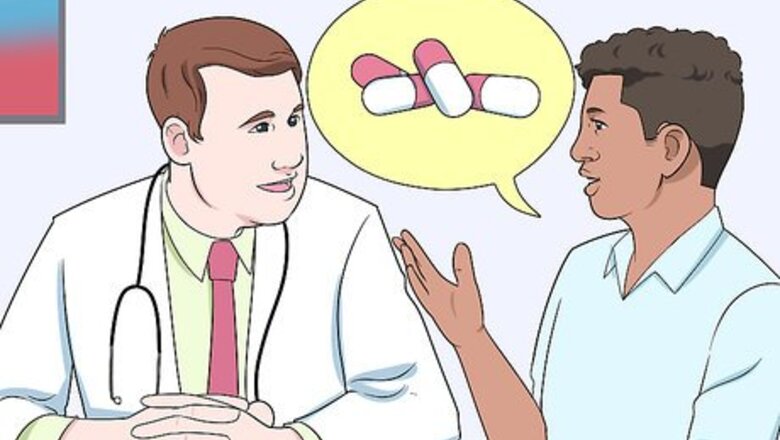
views
X
Trustworthy Source
MedlinePlus
Collection of medical information sourced from the US National Library of Medicine
Go to source
Through the help of medicine and lifestyle changes as instructed by your doctor, you can thin your blood and help keep yourself healthier.
Using Prescription Medication
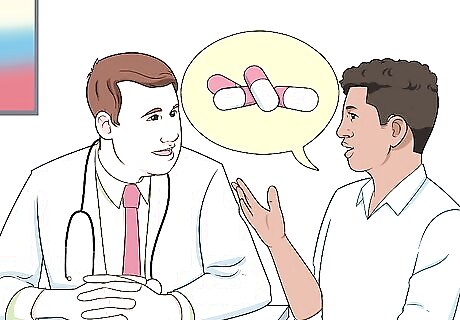
Let your doctor know all vitamins, supplements, and medications you are currently on when you are taking any blood thinner. Seemingly harmless over-the-counter medications, supplements and vitamins can affect the blood thinners such as warfarin/coumadin as well as other drugs.
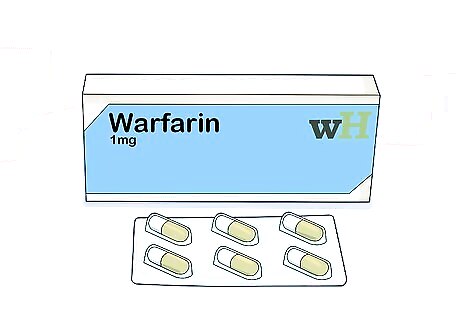
Take coumarin-based medications. If you have suffered from any condition or ailment that requires a blood thinner, your doctor will likely prescribe you an anticoagulant, which are medications that target clotting factors. Your doctor may prescribe you a coumarin-based medication, such as coumadin or warfarin. These work to reduce the formation of vitamin K dependent clotting factors in the blood. It is generally taken by mouth once a day, at the same time every day, with or without food. General side effects include gas, abdominal pain, and some hair loss.
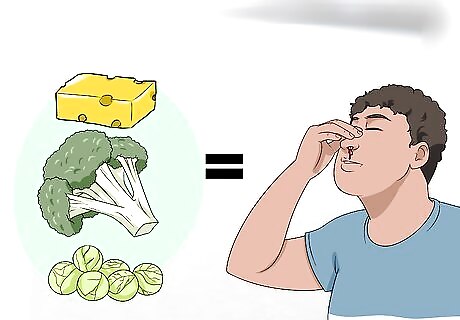
Recognize warfarin side effects. If you are on warfarin therapy, you need to be monitored very closely because warfarin is known to cause internal bleeding. You will need weekly blood tests and your dosages will be adjusted based on your results. Keep your diet consistent when taking warfarin because increased levels of vitamin K can affect your warfarin therapy, make the drug less effective, and not able to prevent clots.-- Warfarin also has many drug interactions so tell your doctor every kind of medication or supplement you take. When on warfarin, avoid eating large or varying amounts of green vegetables, vitamin K rich foods such as broccoli, cauliflower, brussel sprouts, cabbage, kale, spinach, green beans, green tea, liver, and some cheeses. Talk to your healthcare professional about keeping your diet consistent in amount and steadiness with warfarin.
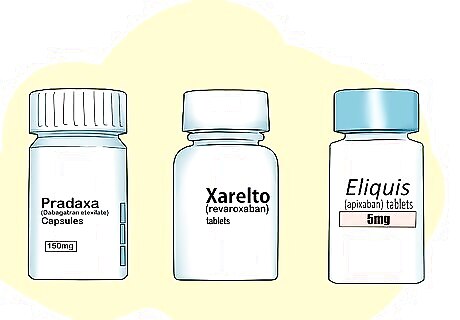
Consider alternatives to warfarin that require avoiding bleeding or hemorrhaging accidents. Your doctor may prescribe you such oral anticoagulants that are gaining popularity. The advantage with these is that you do not need weekly monitoring and vitamin K intake does not affect their effectiveness. But also vitamin K nor any other product can stop bleeding with the new kinds of blood thinners. If bleeding does occur, unlike warfarin, there is no simple way to reverse bleeding or hemorrhaging. Cauterizing for sealing injuries, and icing for several days that contracts the blood vessels of the injury. Your doctor may prescribe Pradaxa, which is usually taken by mouth, with or without food, twice a day. Major side effects of Pradaxa include gastrointestinal symptoms such as upset stomach and nausea. Other serious side effects may include hemorrhage or allergic reaction. Or, you may be prescribed Xarelto. Depending on your particular circumstance, you may be instructed to take this once or twice a day by mouth with food. Side effects of Xarelto include allergic reaction to the medication, bleeding or throwing up blood, dizziness, burning, numbness, tingling, muscle weakness, confusion, and headache. Your doctor may instead prescribe Eliquis, which is usually taken twice a day by mouth, with or without food. Caution should be taken if you notice an allergic reaction, signs of bleeding, dizziness, confusion, headache, joint pain or swelling, chest pain, or wheezing. Another kind of medication is Plavix (clopidogrel) an anti-platelet prescription. It makes blood less sticky and lowers the amount of the "sticky" coagulant platelets (which dangerously would stick together to cause clotting and can also cause blockages in blood vessels). There are some common side effects of Plavix: head pain, muscle and joint pain. You may experience some less frequent side effects of Plavix including danger of bleeding, hemorrhage, nosebleeds, etc.
Using Other Methods

Take baby aspirin carefully. If you have had a heart attack or stroke, or have certain risk factors, your doctor may recommend a daily, 81mg tablet of aspirin. Aspirin thins your blood by preventing blood cells from sticking together, thus decreasing the risk of clots. Be aware, though, that aspirin introduces additional bleeding risks such as a hemorrhagic stroke and GI bleeding. If you have had stomach ulcers, GI bleeding, or are allergic to aspirin, let your doctor know. If you are taking regularly scheduled NSAIDS such as ibuprofen, you may also increase your chances of bleeding. Let your doctor know before starting an aspirin regimen. Aspirin may interact with other medications such as heparin, ibuprofen, Plavix, corticosteroids, and antidepressants as well as herbal supplements such as ginkgo, kava, and cat’s claw.

Incorporate more exercise. Exercise is very important in reducing your risk of heart attack and stroke. Although you cannot undo what damage has been done, you can prevent further complications if you include exercise along with your medication. It is recommended that you exercise 150 minutes a week, which is generally broken up into 30 minutes a day of moderate aerobic activity such as brisk walking. Try to avoid exercise that might cause serious injury, complications, or internal bleeding. Ask your doctor what activities are best given your personal history and the medication you are taking.
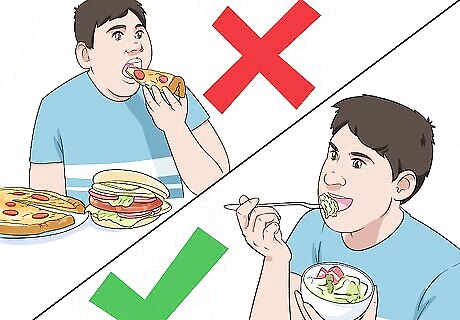
Change your diet. Changing your diet can help to prevent further heart problems. Changing your diet can also enhance the effects of your medication to keep your blood thinner and healthier. Control your portion sizes by using smaller plates and keeping track of how much food you eat at each meal. Eat more fruits and vegetables, which are full of vitamins, nutrients, and antioxidants. Try eating whole grains instead of white flour. Include good fats, such as nuts and oily fish like tuna or salmon. Include lean protein in your diet, such as egg whites, low-fat dairy, and skinless white meat chicken. Eat foods that are low in saturated fat. The foods you eat should have less than 7% of their total calories from saturated fat. You should also avoid trans fats, which should be less than 1% of the foods total calories. Avoid oily, salty, or greasy food, fast food, and frozen, prepackaged food. Even frozen meals that claim to be healthy contain a lot of salt. Also avoid pies, frozen waffles, and muffins.
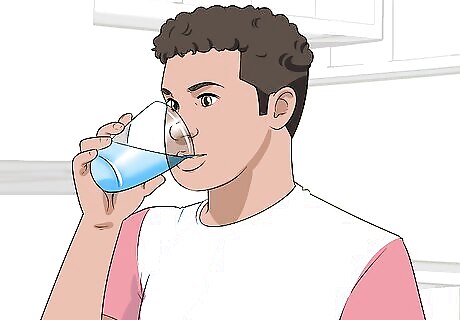
Drink more water. Water is a great natural blood thinner. Dehydration makes your blood thicker, which causes clumps that turn to clots. Drink more water each day to help thin your blood and keep yourself healthier overall. Some doctors suggest drinking around 64 ounces of water every day. Other doctors use the formula that, for every pound you weigh, you need to drink half an ounce of water. For example, if you weight 140 pounds, you should drink 70 ounces of water a day. Don't over-hydrate yourself. Make sure you have plenty of water, but if you feel too full, do not force yourself to drink more water.
Seeking Medical Help

Talk to your doctor. Conditions such as blood clots, pulmonary embolisms, heart attacks, atrial fibrillation, and strokes are life threatening and serious. If they are not treated properly, you are at risk for recurrence. These conditions require regular check ups and care from a doctor. Under your doctor's care, you may be prescribed a medication to help with thinning your blood as well as a special diet. Although certain foods may help thicken or thin your blood, do not attempt to use foods or diet to thin your blood.
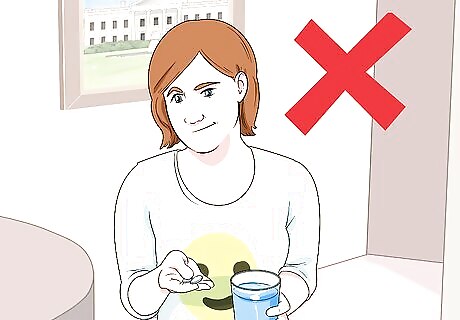
Do not attempt to self-treat. If you are at high risk or have had heart issues or stroke, do not attempt to thin your blood by yourself. Diet and other home remedies alone will not prevent clots or heart attacks. Diet and exercise will only help prevent heart disease early on. Once you have heart disease or have had an episode where your blood needs to be thinned, diet and exercise will not be enough to prevent a stroke or heart attack. Always follow your doctor's advice on diet and medication.
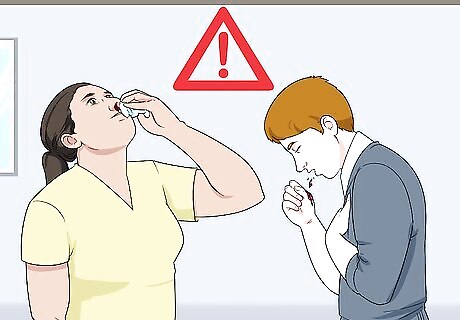
Look for signs of bleeding. If you are currently on an anticoagulant, call your doctor or get medical help right away if you develop any signs or symptoms of significant amount of bleeding. These can also be symptoms of internal bleeding, hemorrhage, or other hidden bleeding. Seek medical attention immediately if you experience unusual bleeding. These instances include nosebleeds that happen repeatedly, unusual bleeding from your gums, and menstrual or vaginal bleeding that is heavier than normal. If you get injured or experience bleeding that is severe and uncontrollable, get emergency care right away. You should seek immediate medical help if you show signs of internal bleeding, such as red, pink, or brown urine; bright red, red-streaked, or black, tar-like stools; coughing up blood or blood clots; vomiting blood or your vomit looks granular like “coffee grounds; headaches; or feeling dizzy, faint or weak.
















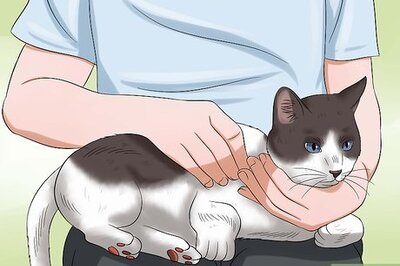



Comments
0 comment